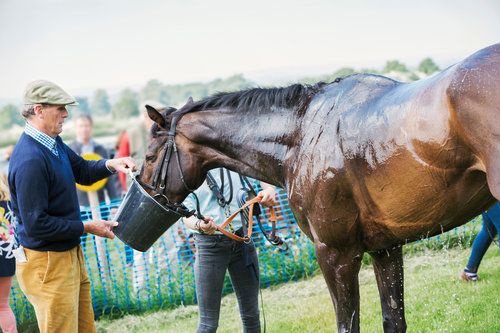Friday 17th June 2022 and the temperature at
Ascot racecourse was 31C. Two days earlier two horses had been pulled up during
the Ascot Stakes. Marshall Plan and Surrey Gold were both reported by the
veterinary officer to be showing signs of heat stress. That day the temperature
was 24C. Despite a level 3 heat-health alert being issued on Friday, (level 4
being a national emergency) racing continued.
A spokesperson from Ascot racecourse Chris Stickels said, "We've raced at Royal Ascot in temperatures of 32C, 33C and 34C before. I don't want to sound flippant but we have plenty of water and devices here to help out with cooling horses. There's lots of water around and we have the cooling misting fans to use too." Meanwhile visitors to the racecourse that day were treated to a relaxed dress code that day to increase human comfort due to the extreme heat.
With royal visitors and high-profile guests attending, the horses comfort seemed less of a priority.
Meanwhile in many greyhound tracks in the UK, dogs were also made to race in these temperatures. The Greyhound Board of Great Britain (GBGB) state in its Rules of Racing outlines specific requirements during the transportation of dogs, including a temperature of 10-27C which must be monitored (McNicholl, 2016), yet they were allowed to run at temperatures more than 31C. Greyhounds do not share quite the same royal status shown to horse racing with dogs subjected to lives of confinement, practices that are cruel, and suffering track related injuries that often result in euthanasia. Greyhounds with their short coats and thin skin are particularly vulnerable to temperature extremes, being prone to heatstroke in hot conditions.
Yet despite this UK politician David Lipsey was quoted on Wednesday saying, “But greyhounds in this country are not “cruelly treated”... They are invariably and passionately loved by the trainers and the staff who look after them. And racing is not cruel or dangerous for the dogs.” (Guardian online, 15.06.22).
The general public seemed to take more care with their companion animals, with advice from vets and pet organisations warning of the dangers of walking dogs in warm temperatures; burned paws on hot asphalt and heatstroke being the main concerns. Pet guardians were urged to keep their furry family well hydrated and cool. Social media reflected this with many reports of dogs in paddling pools or relaxing inside in the shade.
A spokesperson from Ascot racecourse Chris Stickels said, "We've raced at Royal Ascot in temperatures of 32C, 33C and 34C before. I don't want to sound flippant but we have plenty of water and devices here to help out with cooling horses. There's lots of water around and we have the cooling misting fans to use too." Meanwhile visitors to the racecourse that day were treated to a relaxed dress code that day to increase human comfort due to the extreme heat.
With royal visitors and high-profile guests attending, the horses comfort seemed less of a priority.
Meanwhile in many greyhound tracks in the UK, dogs were also made to race in these temperatures. The Greyhound Board of Great Britain (GBGB) state in its Rules of Racing outlines specific requirements during the transportation of dogs, including a temperature of 10-27C which must be monitored (McNicholl, 2016), yet they were allowed to run at temperatures more than 31C. Greyhounds do not share quite the same royal status shown to horse racing with dogs subjected to lives of confinement, practices that are cruel, and suffering track related injuries that often result in euthanasia. Greyhounds with their short coats and thin skin are particularly vulnerable to temperature extremes, being prone to heatstroke in hot conditions.
Yet despite this UK politician David Lipsey was quoted on Wednesday saying, “But greyhounds in this country are not “cruelly treated”... They are invariably and passionately loved by the trainers and the staff who look after them. And racing is not cruel or dangerous for the dogs.” (Guardian online, 15.06.22).
The general public seemed to take more care with their companion animals, with advice from vets and pet organisations warning of the dangers of walking dogs in warm temperatures; burned paws on hot asphalt and heatstroke being the main concerns. Pet guardians were urged to keep their furry family well hydrated and cool. Social media reflected this with many reports of dogs in paddling pools or relaxing inside in the shade.


